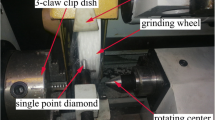Abstract
The effect of roller structural parameters on polishing flow field pressure during linear hydrodynamic polishing (LHP) was optimized by applying orthogonal test design. We used CFD simulation results to analyze the effect of structural parameters on the magnitude and uniformity of hydrodynamic pressure. By using the nlinfit fitting method, multiple nonlinear regression equations for the hydrodynamic pressure mean and mean square deviation of the structural parameters were obtained. A genetic algorithm that could globally search for the optimal solution in the independent variable range was used to obtain optimal structure parameters. We found that the magnitude and uniformity of dynamic pressure on the polished surface were improved. Experimental results showed that surface scratches on the polished surface were significantly reduced, and the excellent surface roughness could be obtained under different polishing processing conditions.










Similar content being viewed by others
References
Wen DH, Piao ZY, Zhang TH (2016) A hydrodynamic suspension polishing method for ultrasmooth and low-damage surface. Precis Eng 46:278–287
Manas D, Jain VK, Ghoshdastidar PS (2008) Analysis of magnetorheological abrasive flow finishing (MRAFF) process. Int J Adv Manuf Technol 38(5-8):613–621
Yuan JL, Lv BH, Hang W, Deng QF (2017) Review on the progress of ultra-precision machining technologies. J Mech Eng-En 12(2):158–180
Huang J, Juszkiewicz M, De JWH, Cerda E, Emrick T, Menon N (2007) Capillary wrinkling of floating thin polymer films. Sci 317:650–653
Malvadkar NA, Hancock MJ, Sekeroglu K, Dressick WJ, Demirel MC (2010) An engineered anisotropic nanofilm with unidirectional wetting properties. Nat Mater 9:1023–1028
Lee H, Wang H, Park J, Jeong H (2014) Experimental investigation of process parameters for roll-type linear chemical mechanical polishing (Roll-CMP) system. Precis Eng 38(4):928–934
Khakpour H, Birglen L, Tahan SA (2015) Uniform scanning path generation for abrasive waterjet polishing of free-form surfaces modeled by triangulated meshes. Int J Adv Manuf Technol 77(5):1167–1176
Piao ZY, Wen DH, Yin LZ, Zhao MM (2019) Ultra-smooth Cu surface fabricated by hydrodynamic suspension polishing technique. Precis Eng 57:189–194
Qi H, Xie Z, Hong T, Wang YY, Kong FZ, Wen DH (2017) CFD modelling of a novel hydrodynamic suspension polishing process for ultra-smooth surface with low residual stress. Powder Technol 317:320–328
Yuan JL, Zhang FH, Dai YF, Kang RK, Yang H, LV BH (2010) Development research of science and technologies in ultra-precision machining field. J Mech Eng-En 46(15):161–177
Namba Y, Ohnishi N, Yoshida S, Harada K, Yoshida K, Matsuo T (2004) Ultra-precision float polishing of calcium fluoride single crystals for deep ultra violet applications. CIRP Ann-Manuf Tech 53(1):459–462
Watanabe J, Suzuki J, Kobayashi A (1981) High precision polishing of semiconductor materials using hydrodynamic principle. CIRP Ann-Manuf Tech 30(1):91–95
Mori Y, Yamauchi K, Endo K (1987) Elastic emission machining. Precis Eng 9(3):123–128
Kubota A, Shinbayashi Y, Mimura H, Sano Y, Inagaki K, Mori Y (2007) Investigation of the surface removal process of silicon carbide in elastic emission machining. J Electron Mater 36(1):92–97
Zhao J, Cao ZQ, Zhan JM, Zhang F, Niu L (2007) Research on hydrodynamic suspension nanoscale polishing for K9 optical glass. Int J Comput Appl Technol 29(2-4):257–261
Ji SM, Yu JF, Hong T, He J (2012) Influence of shapes of grooved polishing tool on hydrodynamic suspension polishing. CSAE 28(1):87–91 (in Chinese)
Zheng ZJ, Xue KY, Wen DH, Xu YY, Ying FQ (2020) Study on hydrodynamic pressure characteristics of linear hydrodynamic pressure polishing. Chin J Mechan Eng 31(8):907–914 (in Chinese)
Zhan JM, Mao JH, Liu QT (2011) Study on experiments of nano-abrasive polishing in hydrodynamic suspension liquid. Appl Mech Mater 44-47:446–450
Peng WQ, Guan CL, Li SY (2013) Ultra-smooth surface polishing based on the hydrodynamic effect. Appl Opt 52(25):6411–6416
Yakhot V, Orszag SA (1986) Renormalization group analysis of turbulence. I Basic theory J Sci Comput 1(1):3–51
Fluent, Ansys Fluent 14.5 User Guide, Ansys Inc, Springer Berlin Heidelberg, New York, 2007.
Luo Q, Ramarajan S, Babu SV (1998) Modification of the Preston equation for the chemical mechanical polishing of copper. Thin Solid Films 335(1):160–167
Liu RJ, Zhang YW, Wen CW (2010) Tang J. Study on the design and analysis methods of orthogonal experiment. Exp Tech & Mgmt 27(9):52–55
Shen QW, Zheng Y, Li SA, Ding HR, Xu YG, Zheng CG (2016) Optimize process parameters of microwave-assisted EDTA method using orthogonal experiment for novel BaCoO3-delta perovskite. J Alloys Compd 658:125–131
Matlab (2012a) User’s Guide (2005) The Mathworks. Inc.
Savas V, Ozay C (2008) The optimization of the surface roughness in the process of tangential turn-milling using genetic algorithm. Int J Adv Manuf Technol 37(3-4):335–340
Saravanan R, Asokan P, Sachidanandam M (2002) A multi-objective genetic algorithm (GA) approach for optimization of surface grinding operations. Int J Mach Tools Manuf 42(12):1327–1334
Availability of data and materials
All data and materials are fully available without restriction.
Funding
This work was financially sponsored by National Natural Science Foundation of China (No. 51775509) and Zhejiang Provincial Natural Science Foundation (No. LZ17E050003).
Author information
Authors and Affiliations
Contributions
Z.X. performed the data analyses and wrote the manuscript; Y.X. performed the experiment; H.Q. contributed significantly to analysis and manuscript preparation; D.C. helped perform the analysis with constructive discussions; D.W. contributed to the conception of the study.
Corresponding author
Ethics declarations
Ethical approval
Compliance with ethical standards
Consent for publication
Written informed consent for publication was obtained from all participants.
Competing interests
The authors declare that they have no conflict of interest.
Additional information
Publisher’s note
Springer Nature remains neutral with regard to jurisdictional claims in published maps and institutional affiliations.
Rights and permissions
About this article
Cite this article
Xie, Z., Xu, Y., Qi, H. et al. Effect of polishing roller structure on pressure distribution during the linear hydrodynamic polishing. Int J Adv Manuf Technol 115, 627–636 (2021). https://doi.org/10.1007/s00170-021-07090-7
Received:
Accepted:
Published:
Issue Date:
DOI: https://doi.org/10.1007/s00170-021-07090-7



